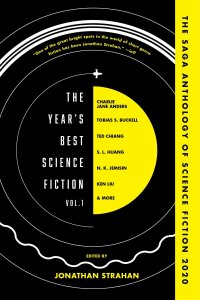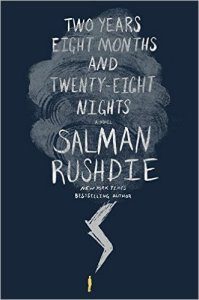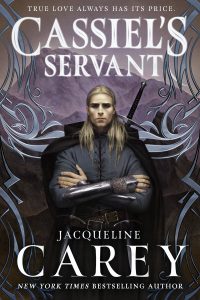Gary K. Wolfe Reviews The Year’s Best Science Fiction: Volume 1, Edited by Jonathan Strahan
 The Year’s Best Science Fiction: Volume 1, Jonathan Strahan, ed. (Saga 978-1-5344-4959-6, $17.99, 570pp, tp) September 2020.
The Year’s Best Science Fiction: Volume 1, Jonathan Strahan, ed. (Saga 978-1-5344-4959-6, $17.99, 570pp, tp) September 2020.
The first thing I noticed about the inaugural volume of Jonathan Strahan’s The Year’s Best Science Fiction for Saga Press (after 13 years of SF and fantasy annuals for other publishers) is that it’s dedicated to the memory of Gardner Dozois, whose dozens of year’s best anthologies remain the baseline for all such efforts since. Strahan is probably right in claiming that Dozois “would have loved these stories,” but that brings up the second thing I noticed about Strahan’s anthology – namely, that, in its eclecticism and international focus, it would barely have been recognizable to the readers of Dozois’s first annual back in 1984. That volume, like the several that immediately followed it, was essentially an anthology of American stories, with a smattering of British or Canadian writers. Strahan’s new volume includes writers from India, the Caribbean, Lebanon, Sweden, China, Spain, Nigeria, Canada, and Australia, all adding up to more than 40% of the selections. This doesn’t mean that Dozois was blind to SF’s multiculturalism (his later volumes increasingly reflected diversity), but simply that SF can no longer be viewed as a predominantly Anglo-American project, and – perhaps just as important – stories from a wide variety of cultures are far more available than they were just a few years ago.
What this means, in part, is that even fairly familiar SF themes can feel new when deployed from different perspectives. The old question of whether we might be unknowingly living in a simulation gains a politically charged resonance when confronted by a Palestinian girl haunted by her dead brother in Saleem Haddad’s “Song of the Birds”, while in Indrapramit Das’s “Kali-Na”, the release in India of a powerful new AI takes its name (and apparently some of its characteristics) from the goddess Devi, offering hope to a young woman who grows up oppressed by that country’s persistent class divisions. Climate catastrophes, not surprisingly, feature in several of the stories, but Chinelo Onwualu’s “What the Dead Man Said” imagines an aftereffect that seems entirely new: the “Great Return”, in which a separatist county called New Biafra manages to attract skilled Igbos to return to Africa; this serves as the background to a painful but moving tale in which the narrator faces a traumatic past after returning for the father’s funeral. In Han Song’s “Submarines”, a good portion of the population has taken to living in makeshift submarines, but it’s not the techno-elite who manage this, but rather migratory peasants who would otherwise have to live in nightmarish camps. Anil Menon’s “The Robots of Eden” raises the question of what the real cost might be of posthuman enhancements, in the context of a moving family drama (including the possible cost to fiction itself). Possibly the most beautifully written story here is Vandana Singh’s “Reunion”, in which a brilliant engineer, credited with having developed the “modern, sensate city” through “embedded intelligence agents in the inanimate world,” looks back on her life as she awaits a journalist bearing news of a long-lost friend who, decades earlier, set out to do something even more ambitious in the Amazon basin.
There are, of course, more familiar pleasures as well. Both Alec Nevala-Lee’s “At the Fall” and Greg Egan’s “This is Not the Way Home” are classic problem-solving tales, but Eunice, the protagonist of Lee’s richly detailed story, is an ocean-floor robot investigating ancient whale-falls, who is faced with saving itself when communication with the surface mysteriously vanishes. Egan’s story, a suspenseful tale of a woman and her infant trapped on the moon when communication with Earth is lost and the moonbase crew abandons them to flee home, is as skillfully told as we expect from Egan, but carries more echoes of Arthur C. Clarke than of Egan’s more radical conceptual experiments. Caroline M. Yoachim’s “The Archronology of Love” begins with a familiar scenario of a planetary colony wiped out by a mysterious plague, but veers into more original territory with its introduction of a strange alien time vault called the Chronicle. Tegan Moore’s “The Work of Wolves” is an enhanced-animal tale, narrated by an intelligent dog and given surprising depth and complexity as the animal faces an unexpected moral quandary. Karin Tidbeck’s “The Last Voyage of Skidbladnir” begins with the classic scenario of an engineer trying keep up with the repairs on a failing spaceship, until we realize that the ship is far more than it at first seems (the main narrative is rather cleverly counterpointed with episodes of an old SF TV series, as if acknowledging its lineage). Elizabeth Bear’s “Soft Edges” is even structured as a murder mystery, with a scientist who is working to combat coastal erosion not only discovering the body, but finding a solution that leads her to a moral dilemma of her own.
In approaching Strahan’s characteristically eclectic selections, I tried not to set about trend-mongering, but the coastal setting of Bear’s tale calls attention to a trend that’s hard to ignore: the extent to which Earth’s hydrosphere seems to be on people’s minds these days, nearly rivaling outer space as a default SF setting. I’ve already mentioned the Yangtze River of Han Song’s “Submarines” and the ocean-floor setting of Nevala-Lee’s tale, but the fate of the oceans also figures prominently in Malka Older’s “Sturdy Lantern and Ladders”, a surprisingly hopeful tale about a project to use the memories of cephalopods to begin to reconstruct coral reefs, while Peter Watts’s predictably meticulous and provocative “Cyclopteros” returns us to a deep-sea setting with a tale of a submersible exploring oceans whose surfaces are devastated by ongoing superstorms; just who the protagonist is and what his real mission is leads to a brutally effective twist ending. Fran Wilde’s “A Catalog of Storms” also deals with violent coastal weather, but in a manner that suggests Margo Lanagan’s psychic naturescapes more than any sort of traditional SF; a village is protected from storms by sending young volunteers to become “weathermen” who challenge and try to control storms partly by naming them.
If it’s no surprise that climate-related fiction should be prominent these days, neither is it surprising that dystopian themes should show up (especially since so many mainstream commentators seem to think that’s all that SF is obsessed with). Indeed, there are a few familiar-looking dystopias, such as the repressive US and more liberal California that meet in a border-straddling shop in Charlie Jane Anders’s “The Bookstore at the End of America” (which turns out to be less a nightmare than a paean to books), or Ted Chiang’s “It’s 2059, and the Rich Kids Are Still Winning”, one of a series of futuristic op-eds commissioned by the New York Times last year (and thus hardly a characteristic Chiang story), essentially arguing that simple genetic improvements can’t erase societal inequities. The most acerbic such tales often gain their effects through bitter irony, introducing us to grotesque societies that think they’re utopian (someone once suggested “anti-utopian” to distinguish these from run-of-the-mill miseries). N.K. Jemisin’s Hugo Award winning “Emergency Skin” signals its irony early on, with references to “classical patrician features,” “mankind,” “great men,” etc. We learn the narrator is a companion AI addressing a representative sent back to a supposedly dead Earth from a colony world that has no doubts of its racial and cultural superiority (since the colony was founded on just those assumptions). Far from being extinct, the lively Earthlings are neither surprised nor impressed by the visitor, though Jemisin’s valorization of messy humanity over a self-satisfied “utopia” isn’t particularly subtle or original. More unsettling are Rich Larson’s “Contagion’s Eve at the House Noctambulous” and E. Lily Yu’s “Green Glass: A Love Story”, both of which deal with wildly decadent elites in damaged worlds, Yu focusing on a bride determined to spare no expense in order to have real ice cream at her wedding, Larson borrowing a page from “The Most Dangerous Game” in an effete but brutally class-divided future. Ken Liu’s “Thoughts and Prayers” brings dystopia much closer to home, as family members of a mass shooting victim have to cope with internet trolls turning her online memorial into porn. (Trolls also figure significantly in Das’s AI/goddess tale “KaliNa”, suggesting that they might be on the list of SF’s emerging go-to villains.) In Hugo Award winner “As the Last I May Know”, S.L. Huang sets up an almost Omelas-like dilemma for a newly elected president who seems all too willing to employ an apocalyptic weapon – but who has to personally kill a child in whose body the launch codes are hidden.
While the environmental and political backgrounds of many of these tales may seem pretty grim, Strahan does offer a leavening of humor with Fonda Lee’s “I (28M) Created a Deepfake Girlfriend and Now My Parents Think We’re Getting Married”, which is pretty much what you’d think from that title, and Tobias S. Buckell’s “The Galactic Tourist Industrial Complex”, which evokes the satirical edge of Sheckley in a tale of a New York cabbie who gets into trouble when a wealthy alien tourist leaps from his aerial cab – but in fact may be inadvertently transforming the whole real estate market. Finally, there seems to be one story in every anthology that reads like no other, and for me that would be Sofia Rhei’s “Secret Stories of Doors”, in which Barcelona has become the hub of an ongoing and apparently infinite World Encyclopedia. The protagonist takes secret pride in constructing whole systems of fictional entries, but soon finds he’s not the only one. The ingenious interpenetration of fiction and truth, text and world, lends the whole a deliciously Borgesian tone. It’s not a typical story in Strahan’s anthology, but perhaps the main strength of his selection process is that, even though we can readily situate each tale within the framework of contemporary SF, none of the stories are typical, and not all will appeal to all readers – but if mapping clouds is what the modern SF anthologist needs to do, then Strahan (who of course is both a Locus colleague and a podcast partner) seems especially well equipped to do it.
Gary K. Wolfe is Emeritus Professor of Humanities at Roosevelt University and a reviewer for Locus magazine since 1991. His reviews have been collected in Soundings (BSFA Award 2006; Hugo nominee), Bearings (Hugo nominee 2011), and Sightings (2011), and his Evaporating Genres: Essays on Fantastic Literature (Wesleyan) received the Locus Award in 2012. Earlier books include The Known and the Unknown: The Iconography of Science Fiction (Eaton Award, 1981), Harlan Ellison: The Edge of Forever (with Ellen Weil, 2002), and David Lindsay (1982). For the Library of America, he edited American Science Fiction: Nine Classic Novels of the 1950s in 2012, with a similar set for the 1960s forthcoming. He has received the Pilgrim Award from the Science Fiction Research Association, the Distinguished Scholarship Award from the International Association for the Fantastic in the Arts, and a Special World Fantasy Award for criticism. His 24-lecture series How Great Science Fiction Works appeared from The Great Courses in 2016. He has received six Hugo nominations, two for his reviews collections and four for The Coode Street Podcast, which he has co-hosted with Jonathan Strahan for more than 300 episodes. He lives in Chicago.
This review and more like it in the November 2020 issue of Locus.
 While you are here, please take a moment to support Locus with a one-time or recurring donation. We rely on reader donations to keep the magazine and site going, and would like to keep the site paywall free, but WE NEED YOUR FINANCIAL SUPPORT to continue quality coverage of the science fiction and fantasy field.
While you are here, please take a moment to support Locus with a one-time or recurring donation. We rely on reader donations to keep the magazine and site going, and would like to keep the site paywall free, but WE NEED YOUR FINANCIAL SUPPORT to continue quality coverage of the science fiction and fantasy field.
©Locus Magazine. Copyrighted material may not be republished without permission of LSFF.







